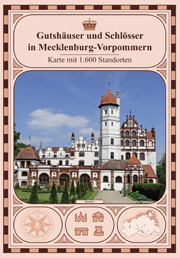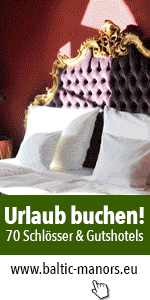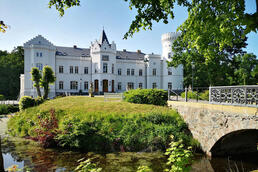Deutsche Website
Map of manor house locations in Mecklenburg

On the map you will find approx. 1600 locations of manor houses, manor houses, castles and palaces.
Order form
Book "Manor houses and castles in Western Pomerania"

In Volume 2, we present 45 estates with short texts and more than 220 historical and current photographs on 155 pages.
Manor House (Castle) Schlemmin bei Ribnitz-Damgarten
Schlemmin is an old estate of the von Thun family, who were based in Western Pomerania and Mecklenburg. In 1283, a Heinricus de Thune was mentioned in the country's peace treaty of the Wendish Baltic See states.
Since 1320, this family has been mentioned in connection to Schlemmin. The Thuns had a castle in Schlemmin in the 14th century, which was rebuilt over the centuries and was still present in the 19th century. The Neo-Gothic, castle-like manor house with Neo-Renaissance features was built between 1846 and 1850 by the architect and builder Eduard Knoblauch. Its construction had been commissioned by Wilhelm Ulrich von Thun (*1784 – 1862). With the marriage of Emma von Thun and Otto Graf Solms-Rödelheim, the castle and the rest of the property changed hands. Emma and Otto’s daughter, Bertha Thekla, married Count Ferdinand of Stolberg-Wernigerode in 1892. Their son, Count Günther, then married Emma von Plathen in 1923. In 1931, her daughter Sybille was born. After the death of Günther, Count of Stolberg-Wernigerode, the property was taken up by the joint heirs: his widow and three children.
In 1936, the estate was given an administrator, who was endowed with all powers. After the castle had been empty for several years, a hospital was set up in 1943. At the end of 1944, it served as a shelter to the first refugees from the East. The burial plots in the castle grounds are also from these years. The property of the Stolberg-Wernigerode heiress had a total size of about 4,000 ha.
In May 1945, the Red Army occupied the town. This marked the end to the reign of the noble family, who were forced to flee to the West. During the early GDR period, the castle housed 160 refugees from East Prussia, Pomerania, Silesia, and the Sudetenland. A sales point had been established in the music hall, and there was a school in the castle. In 1970, it became a guesthouse of the “Rotes Banner” Agricultural Cooperative from Trinwillershagen. It was also the seat for the SED political office as well as several ministers and officials. Training and brigade festivals were also held here.
In 1991, the municipality of Schlemmin acquired ownership of the castle. A company group from Berlin tried to run the building as a castle hotel until 1992 but were unsuccessful. The castle was then adopted under the asset management of the Federal Agricultural Production Cooperative. In 1999, Horst Sander of Bremen bought the building and saved it from decay. It has now been completely renovated and modernized. It now houses “Park-Hotel Schloss Schlemmin”, which is open and accessible to the public.
The 23-hectare castle park is filled with numerous 800-year-old oaks, a charming avenue of linden trees as well as a fruit and herb garden. It was established as a Baroque park in the 18th century and was adjoined to an old beech and oak forest. It was later transformed into an English landscape park in the 19th century.



